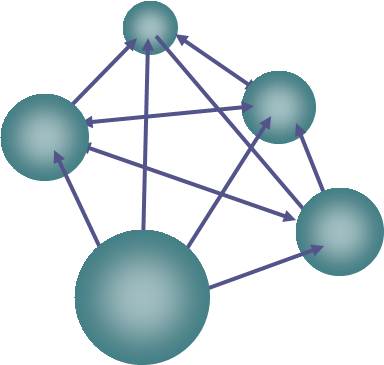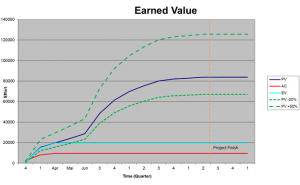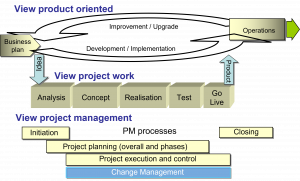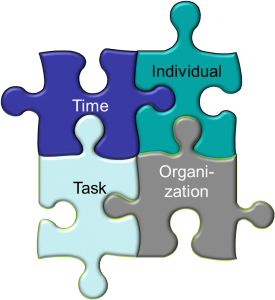Actually it is easy to remedy projects in distress. Because the causes are usually as trivial as the resolutions for the Project Recovery.
The Classic
A project quarrels with the departments involved about resources. It needs skilled people with good knowledge on the topic, but the line needs these, too, and is not willing to dedicate them except (if at all) some who are on the bench anyway – a classic. In the end both are loosing because it will not work as planned that way. Sounds logical, doesn’t it? The solution: The departments do desire something from the project. So put them into the driver seat, make them “Product Owners”, take them into the responsibility !
Often the problems are at hand, but the customer is defending the resolution.

A project in Public Administration was about 6 weeks before it’s Go-live. That had been postponed several times already (total project duration 1 ½ years so far), and the budget was exceeded by far. Already at the first talks upfront in a video call I heard that project roles and responsibilities were not clear yet, the IT supplier did not deliver to whatever planning, and that the Go-live must happen now by any means. Well, I think I have an idea…
Ironically enough they played very budget sensible due to strict release processes etc., and they decided for a “cheaper” solution for the Project Recovery. If only it weren’t tax funds again, I wouldn’t have cared!

Apropos budget – another example:
A big energy company planned a business critical project (I knew it would be a program for the Project Recovery) to implement very specific software. For that there are not too many project managers with an adequate experience available out there, but I had done that two times before successfully. However the daily rate budgeted for project management did fit for average skilled project managers without special knowhow, and they were not willing to “needlessly” increase the budget. At the moment of this decision they de facto increased the project budget needlessly and significantly…
Or the advised company does not see the point behind the proposed solutions. This is what happened after a revision of an SAP S/4HANA project that had already failed to see 3 planned go-lives in 3 1/2 years and had exceeded its planned budget by several million Euros. The audit revealed a total failure of the project management, also at the implementation service provider, because the customer refused to accept even the basic features of a structured approach (e.g. according to SAP Activate Best Practices). Project management would only have disrupted the daily routines, an added value of the “overhead” could not be conveyed.
That means I can’t rescue not every project or safeguard it from distress, in particular if I’m not allowed to. This category also applies to two more cases. Here however I had already some time to prepare recovery measures.
(Survival) critical measures cancelled due to resource bottlenecks

At the first one the management and a little group of engaged people compiled a huge catalogue of ideas how to establish our AfterSales with lots of customer benefits in a mature market to intensify this profitable business, and protect and increase market share. All were clear that this was, though technologically leading, without alternative to stay market relevant in a few years. I defined these ideas to initiatives and projects, and structured them sequenced and correlating as a program. Some of them we even started to execute.
Then some of the managing directors in some emerging markets considered that they were doing quite well as is, and that they had too few resources. Budgets were cut; the company was too “lean” to execute the projects. Project Recovery would mean here: You should sharpen the saw in summer to go to the woods before onset of winter, or you will have to leave chances at hand.
Being not able (or willing) to understand, and desiring too much in one chunk
In the second case we talked about a engineering company’s business unit running out of rudder (organizational as well as financial). They wanted to place new and future promising products in the market based on a few contracts with pilot customers. But R+D and customer projects went quite unsynchronized, followed by long delays on committed milestones, and the risk of high liquidate damages, cancelled series orders, and the loss of market advantages. We simply had too few resources for increasing (on top of the pilots) customer projects, and development projects did not keep pace – using the same resources – with their delivery. The cause-effect-mechanism is clear, isn’t it?!
So I started for Project Recovery as the business unit’s programme manager to establish structure, tools, and processes to control resources, interdependencies, joint risk, and communication between the involved parties and stakeholders – following the motto “to build a fence before catching the chickens”. Also we implemented some circles with my moderation to better coordinate the customer and R&D projects. Recruiting was getting up to speed, and for software development which repeatedly trashed our milestones I was planning project reviews.

Then my contract wasn’t renewed. The unit lead had not understood, what I did, what programme management meant, and what was necessary to do, rather was focused on the external picture towards the C-level than to the program’s content, and may be saw a competition in my activity which I could not dispel. Despite we already were completely overloaded, she accepted, while complaining the resource situation to the management, three more customer projects she “could not let go”, hoping she could generate nicer figures for the business unit. I cross my fingers for my colleagues…
Each consultation only can be as good as the consultee is allowing
Sometimes it just comes with too much transparency, uncomfortable truths and or unpleasant Must Dos – especially if things are that obvious and trivial. Life definitely writes the best stories to tell. But there are also the good examples without resistance to take advice and learn. And these are the cases that take companies and employees further without any feeling to throw good money after bad.
Learn more about Project Recovery…













 Today I’d like to tell you about two examples that show why Earned Value Management is not as popular as it should in projects here in Germany, and how, in these cases, reservations have been overcome and implementation was completed successfully. I’d first like to mention that I’m a “fan” of this method, just because it is universal and uncomplicated to use, and because it provides a valid status determination as well as forecasts for Project Management with a few simple formulas.
Today I’d like to tell you about two examples that show why Earned Value Management is not as popular as it should in projects here in Germany, and how, in these cases, reservations have been overcome and implementation was completed successfully. I’d first like to mention that I’m a “fan” of this method, just because it is universal and uncomplicated to use, and because it provides a valid status determination as well as forecasts for Project Management with a few simple formulas. and during this time developing something new and unique (product or
and during this time developing something new and unique (product or  There is very few focus on skills or an education in what I understand with project management, i.e. professional handling of uncertainty, risk, changing scope, schedule and cost planning, team building, team and supplier coordination, communication, leadership etc., actually planning and controlling the project. It seems to be not critical or necessary in this kind of fairly controlled environment, or it is thought to be easily done “at the side”. In many companies there is a technical lead responsible for this kind of work, and the project managers often care for many projects in parallel.
There is very few focus on skills or an education in what I understand with project management, i.e. professional handling of uncertainty, risk, changing scope, schedule and cost planning, team building, team and supplier coordination, communication, leadership etc., actually planning and controlling the project. It seems to be not critical or necessary in this kind of fairly controlled environment, or it is thought to be easily done “at the side”. In many companies there is a technical lead responsible for this kind of work, and the project managers often care for many projects in parallel. creative activities are necessary besides technical work. Therefore the presence of uncertainty and risk is incomparably higher, exchange of ideas, team communication and collaboration are critical success factors.
creative activities are necessary besides technical work. Therefore the presence of uncertainty and risk is incomparably higher, exchange of ideas, team communication and collaboration are critical success factors.
 Four major root causes
Four major root causes In one of my case studies (
In one of my case studies ( If you want to lead a project successfully you need, similar as in other professions, a good, methodical education which includes recognizing the specific project situation’s requirements and reasonably applying the adequate tools and techniques situatively and virtuously. That’s at project management like with craftsmanship where you find trainees, advanced and masters.
If you want to lead a project successfully you need, similar as in other professions, a good, methodical education which includes recognizing the specific project situation’s requirements and reasonably applying the adequate tools and techniques situatively and virtuously. That’s at project management like with craftsmanship where you find trainees, advanced and masters. Therefore a good project manager would not have undergone flaws like in our case because he would have taken care for a clear target and task definition from the start, and would have requested his superiors’ support consequently – for the sake of his project and himself. His planning would have based on realistic assumptions, and he would have identified and escalated risks and deviations and initiated counter measures early.
Therefore a good project manager would not have undergone flaws like in our case because he would have taken care for a clear target and task definition from the start, and would have requested his superiors’ support consequently – for the sake of his project and himself. His planning would have based on realistic assumptions, and he would have identified and escalated risks and deviations and initiated counter measures early. To achieve he also needs another skill: leadership qualities. He is his project’s manager, responsible for the result, and he must steer his team and his superiors so that each one contributes his part to the whole. Not an easy task, in particular if the company doesn’t work project affine. And not everybody is the person for a leadership role, feels well in it. But if he takes his job serious he will apply project management including leadership consequently. Otherwise he will soon become a scape goat if the project fails. Not a very motivating perspective, or a subject for opportunistic PM nomads who sometimes call themselves project managers…
To achieve he also needs another skill: leadership qualities. He is his project’s manager, responsible for the result, and he must steer his team and his superiors so that each one contributes his part to the whole. Not an easy task, in particular if the company doesn’t work project affine. And not everybody is the person for a leadership role, feels well in it. But if he takes his job serious he will apply project management including leadership consequently. Otherwise he will soon become a scape goat if the project fails. Not a very motivating perspective, or a subject for opportunistic PM nomads who sometimes call themselves project managers… Another frequent factor for troubled projects is time. I don’t mean the duration granted to the project for execution. This actually should always be sized realistic, not determined by wish thinking or arbitrarily. That means it must be based on realistic estimates done by the executing team members and taking the interdependences and frame conditions into account. Therefore “duration” falls into the category “Individual” for me, i.e. that the project manager does a competent job.
Another frequent factor for troubled projects is time. I don’t mean the duration granted to the project for execution. This actually should always be sized realistic, not determined by wish thinking or arbitrarily. That means it must be based on realistic estimates done by the executing team members and taking the interdependences and frame conditions into account. Therefore “duration” falls into the category “Individual” for me, i.e. that the project manager does a competent job. In fact many statistics, e.g. the one at
In fact many statistics, e.g. the one at  So the predominant part of project issues arises out of an insufficient support from the executing organization, which in turn is founded in the project culture, the management’s and established organization’s mindset.
So the predominant part of project issues arises out of an insufficient support from the executing organization, which in turn is founded in the project culture, the management’s and established organization’s mindset.
